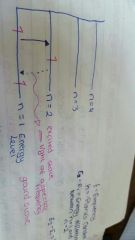![]()
![]()
![]()
Use LEFT and RIGHT arrow keys to navigate between flashcards;
Use UP and DOWN arrow keys to flip the card;
H to show hint;
A reads text to speech;
35 Cards in this Set
- Front
- Back
|
Cathode Rays |
Streams of negatively charged particles called electrons. They travel in straight lines from cathode to the anode and have enough energy to move a small object |
|
|
An Energy Level |
The fixed energy value that an electron in an atom may have |
|
|
Orbital |
A region in space within there is a high probability of finding an electron |
|
|
Isotopes |
Atoms of the same element (same atomic number) which have different number of neutrons. |
|
|
An Ionic Bond |
The force of attraction between oppositely charged ions in compound |
|
|
Linear bond angle |
180° |
|
|
Trigonal Planar |
120° |
|
|
Tetrahedral |
109.5° |
|
|
Pyramidal |
107° |
|
|
V -Shaped |
104.5° |
|
|
Electronegativity |
The relative attraction that an atom in a molecule has for the shared pair of electrons in a covalent bond |
|
|
Polar Covalent Bond |
Where there is unequal sharing of the pair (or pairs) of electrons. This causes one end to be slightly §+ and the other §- |
|
|
Intramolecular Bonding |
Is the bonding that takes place within a molecule, it holds the atoms together. E.g Covalent/polar Covalent bonding |
|
|
Intermolecular Forces |
Are the forces of attraction that exist between molecules e.g Van de Waals, dipole -dipole, hydrogen bonding |
|
|
Atomic Radius |
Is half the distance between the nuclei of two atoms of the same element that are joined together by a single Covalent bond |
|
|
First Ionisation Energy |
The minimum energy required to completely remove the most loosely bound electron from a neutral gaseous atom in the ground state |
|
|
A Standard Solution |
Is a solution whose concentration is accurately known |
|
|
A Primary Substance |
A substance that can be obtained in a stable,pure and soluble solid form so that it can be weighed out and dissolved in water to give a standard solution |
|
|
Oxidation |
When an element loses electrons |
|
|
Reduction |
When an element gains electrons |
|
|
Oxidation Number |
Is the charge than an atom has or appears to have when electrons are distributed according to certain rules. |
|
|
Rate of Reaction |
Is the change in concentration per unit time of any reactant or product |
|
|
A Catalyst |
A substance that alters the rate of a chemical reaction but is not consumed itself |
|
|
Homogeneous Catalysis |
When the reactants and the Catalyst are in the same phase. There is no boundary between the reactant and the Catalyst. |
|
|
Heterogeneous Catalysis |
When the reactants and the Catalyst are in different phases. There is a boundary |
|
|
Effective Collision |
A Collision that results is the formation of products |
|
|
Activation Energy |
The minimum energy that colliding particles must have for a reaction to occcur |
|
|
Hydrocarbon |
A compound that contains carbons and hydrogen only |
|
|
Saturated Compound |
One with only single bonds |
|
|
Structural Isomers |
Are compounds with the same molecular formula but different structural formula |
|
|
Heisenberg's Uncertainty Principle |
It is impossible to measure at the same time both the velocity and the position of an electron |
|
|
Aufbau Principle |
When building up the electron configuration in an atom in its ground state,the electron occupy the lowest available energy level. |
|
|
Pauli Exclusion Principle |
No more than two electrons can occupy am orbital and they must had opposite spin |
|
|
Hunds Rule |
When 2 or more orbitals odd equal energy are available, electrons occupy them singly before filling them in pairs |
|

6 |
1. As long as the electron remains in its energy level it neither gains nor loses energy. 2.the energy level an electron normally occupies is the ground state. 3.when it receives a burst of energy it absorbs it and moves to a higher level (excited state) 4. It is unstable so it drop back down 5.emitting energy as a light of specific wavelength or frequently 6.the lights corresponds to particular line in the emission spectrum and is equal in energy to the difference between the two energy levels |

